Plano-Convex Cylindrical Lenses, N-BK7, Uncoated
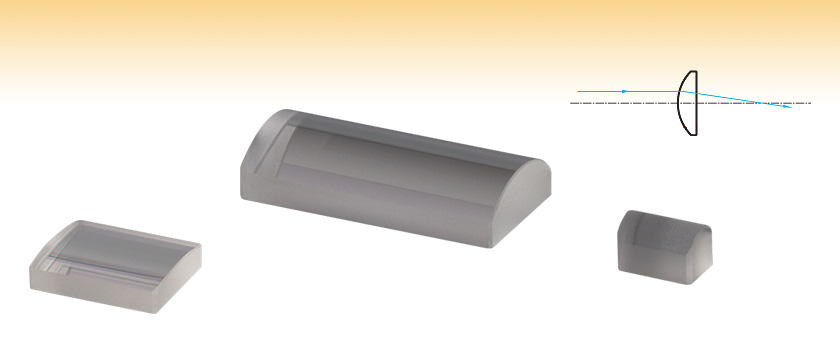
- Ideal for Applications Requiring Magnification in One Dimension
- Provide Anamorphic Shaping of a Beam
- Collimates & Circularizes the Output of a Laser Diode
LJ1402L1
LJ1942L2
LJ1598L1

Please Wait
| Common Specifications | ||
|---|---|---|
| Substrate Material | N-BK7a | |
| Uncoated Wavelength Rangeb | 350 nm - 2.0 µm | |
| Design Wavelength | 587.6 nm | |
| Length Tolerance | +0.00 / -0.10 mm | |
| Height Tolerance | +0.00 / -0.10 mm | |
| Center Thickness Tolerance | ±0.1 mm | |
| Focal Length Tolerance | ±1% | |
| Surface Quality | 60-40 Scratch-Dig | |
| Centration | For f ≤50 mm: ≤5 arcmin For f >50 mm: ≤3 arcmin |
|
| Surface Flatness (Plano Side) |
Height | λ/2 |
| Length | λ/2 | |
| Cylindrical Surface Powerc (Convex Side) |
Height | 3λ/2 |
| Length | 3λ/2 | |
| Irregularity (Peak to Valley) |
Height (Plano, Curved) | λ/4, λ |
| Length (Plano, Curved) | λ/4, λ/cm | |
| Clear Aperture | >90% of Surface Dimensions | |
Features
- Fabricated from N-BK7 Glass
- Collimates and Circularizes the Output of a Laser Diode
- Uncoated Wavelength Range: 350 nm - 2.0 µm
- Focal Lengths from 3.91 mm to 1000.00 mm
- Focal Length Tolerance is ±1%
Positive cylindrical lenses are ideal for applications requiring magnification in one dimension. While spherical lenses act symmetrically in two dimensions on an incident ray, cylindrical lenses act in the same manner but only in one dimension. A typical application is to use a pair of cylindrical lenses to provide anamorphic shaping of a beam. A pair of positive cylindrical lenses can be used to collimate and circularize the output of a laser diode. Another application possibility would be to use a single lens to focus a diverging beam onto a detector array. To minimize the introduction of spherical aberrations, collimated light should be incident on the curved surface when focusing it to a line, and light from a line source should be incident on the plano surface when collimating.
These N-BK7 Plano-Convex Cylindrical lenses are available uncoated or with one of three Antireflection Coatings, which can reduce the amount of light reflected from each surface of the lens. The uncoated lenses are highlighted on this page. Lenses with a -A (350 - 700 nm range), -B (650 - 1050 nm range), or -C (1050 - 1700 nm range) antireflection coating are featured elsewhere. Please see the Graphs tab for coating information.
For cage system and lens tube compatibility, please see our Mounted Plano-Convex Round Cylindrical lenses. These lenses are typically easier to integrate into our standard optomechanics.
| Click on the red Document icon next to the item numbers below to access the Zemax file download. Our entire Zemax Catalog is also available. |
| Plano-Convex Cylindrical Lens Selection Guide | ||||
|---|---|---|---|---|
| Substrate | N-BK7 | UV Fused Silica | N-BK7 (Round) |
UV Fused Silica (Round) |
| AR Coating Range |
Uncoated 350 - 700 nm 650 - 1050 nm 1050 - 1700 nm |
Uncoated 245 - 400 nm 350 - 700 nm 650 - 1050 nm 1050 - 1700 nm |
Uncoated 350 - 700 nm 650 - 1050 nm 1050 - 1700 nm |
Uncoated 350 - 700 nm 650 - 1050 nm 1050 - 1700 nm |
All cylindrical lenses can be ordered uncoated and the cylindrical lenses made from N-BK7 can be ordered with one of the following broadband AR coatings:
-A: 350-700 nm, -B: 650-1050 nm, or -C: 1050-1700 nm
These high-performance multilayer AR coatings have an average reflectance of less than 0.5% (per surface) across the specified wavelength ranges. The central peak in each curve is less than 0.25%. These coatings provide good performance for angles of incidence (AOI) between 0° and 30° (0.5 NA). For optics intended to be used at large angles, consider using a custom coating optimized at a 45° angle of incidence; this custom coating is effective from 25° to 52°. The plot shown below indicates the performance of the standard coatings in this family as a function of wavelength.

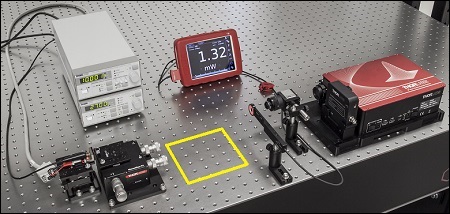
Click to Enlarge
Figure 1: The beam circularization systems were placed in the area of the experimental setup highlighted by the yellow rectangle.
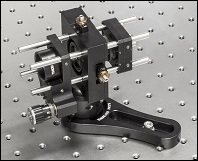
Click to Enlarge
Figure 4: Spatial Filter System
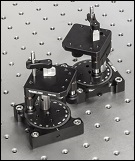
Click to Enlarge
Figure 3: Anamorphic Prism Pair System
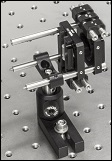
Click to Enlarge
Figure 2: Cylindrical Lens Pair System
Comparison of Circularization Techniques for Elliptical Beams
Edge-emitting laser diodes emit elliptical beams as a consequence of the rectangular cross sections of their emission apertures. The component of the beam corresponding to the narrower dimension of the aperture has a greater divergence angle than the orthogonal beam component. As one component diverges more rapidly than the other, the beam shape is elliptical rather than circular.
Elliptical beam shapes can be undesirable, as the spot size of the focused beam is larger than if the beam were circular, and as larger spot sizes have lower irradiances (power per area). Techniques for circularizing an elliptical beam include those based on a pair of cylindrical lenses, an anamorphic prism pair, or a spatial filter. This work investigated all three approaches. The characteristics of the circularized beams were evaluated by performing M2 measurements, wavefront measurements, and measuring the transmitted power.
While it was demonstrated that each circularization technique improves the circularity of the elliptical input beam, each technique was shown to provide a different balance of circularization, beam quality, and transmitted power. The results of this work, which are documented in this Lab Fact, indicate that an application's specific requirements will determine which is the best circularization technique to choose.
Experimental Design and Setup
The experimental setup is shown in Figure 1. The elliptically-shaped, collimated beam of a temperature-stabilized 670 nm laser diode was input to each of our circularization systems shown in Figures 2 through 4. Collimation results in a low-divergence beam, but it does not affect the beam shape. Each system was based on one of the following:
- LJ1874L2-A and LJ1638L1-A Plano-Convex Convex Cylindrical Lenses (Figure 2)
- PS873-A Unmounted Anamorphic Prism Pair (Figure 3)
- Previous Generation KT310 Spatial Filter System with P5S Ø5 µm Pinhole (Figure 4)
The beam circularization systems, shown to the right, were placed, one at a time, in the vacant spot in the setup highlighted by the yellow rectangle. With this arrangement, it was possible to use the same experimental conditions when evaluating each circularization technique, which allowed the performance of each to be directly compared with the others. This experimental constraint required the use of fixturing that was not optimally compact, as well as the use of an unmounted anamorphic prism pair, instead of a more convenient mounted and pre-aligned anamorphic prism pair.
The characteristics of the beams output by the different circularization systems were evaluated by making measurements using a power meter, a wavefront sensor, and an M2 system. In the image of the experimental setup, all of these systems are shown on the right side of the table for illustrative purposes; they were used one at a time. The power meter was used to determine how much the beam circularization system attenuated the intensity of the input laser beam. The wavefront sensor provided a way to measure the aberrations of the output beam. The M2 system measurement describes the resemblance of the output beam to a Gaussian beam. Ideally, the circularization systems would not attenuate or aberrate the laser beam, and they would output a perfectly Gaussian beam.
Edge-emitting laser diodes also emit astigmatic beams, and it can be desirable to force the displaced focal points of the orthogonal beam components to overlap. Of the three circularization techniques investigated in this work, only the cylindrical lens pair can also compensate for astigmatism. The displacement between the focal spots of the orthogonal beam components were measured for each circularization technique. In the case of the cylindrical lens pair, their configuration was tuned to minimize the astigmatism in the laser beam. The astigmatism was reported as a normalized quantity.
Experimental Results
The experimental results are summarized in the following table, in which the green cells identify the best result in each category. Each circularization approach has its benefits. The best circularization technique for an application is determined by the system’s requirements for beam quality, transmitted optical power, and setup constraints.
Spatial filtering significantly improved the circularity and quality of the beam, but the beam had low transmitted power. The cylindrical lens pair provided a well-circularized beam and balanced circularization and beam quality with transmitted power. In addition, the cylindrical lens pair compensated for much of the beam's astigmatism. The circularity of the beam provided by the anamorphic prism pair compared well to that of the cylindrical lens pair. The beam output from the prisms had better M2 values and less wavefront error than the cylindrical lenses, but the transmitted power was lower.
| Method | Beam Intensity Profile | Circularitya | M2 Values | RMS Wavefront | Transmitted Power | Normalized Astigmatismb |
|---|---|---|---|---|---|---|
| Collimated Source Output (No Circularization Technique) |
 Click to Enlarge Scale in Microns |
0.36 | Y Axis: 1.63 |
0.17 | Not Applicable | 0.67 |
| Cylindrical Lens Pair |  Click to Enlarge Scale in Microns |
0.84 | X Axis: 1.90 Y Axis: 1.93 |
0.30 | 91% | 0.06 |
| Anamorphic Prism Pair |
 Click to Enlarge Scale in Microns |
0.82 | X Axis: 1.60 Y Axis: 1.46 |
0.16 | 80% | 1.25 |
| Spatial Filter |  Click to Enlarge Scale in Microns |
0.93 | X Axis: 1.05 Y Axis: 1.10 |
0.10 | 34% | 0.36 |
Components used in each circularization system were chosen to allow the same experimental setup be used for all experiments. This had the desired effect of allowing the results of all circularization techniques to be directly compared; however, optimizing the setup for a circularization technique could have improved its performance. The mounts used for the collimating lens and the anamorphic prism pair enabled easy manipulation and integration into this experimental system. It is possible that using smaller mounts would improve results by allowing the members of each pair to be more precisely positioned with respect to one another. In addition, using made-to-order cylindrical lenses with customized focal lengths may have improved the results of the cylindrical lens pair circularization system. All results may have been affected by the use of the beam profiler software algorithm to determine the beam radii used in the circularity calculation.
Additional Information
Some information describing selection and configuration procedures for several components used in this experimental work can be accessed by clicking the following hyperlinks:
| Posted Comments: | |
stenss
(posted 2013-11-01 16:05:46.98) Hello! Is there a damage threshold for the lenses? I have a LJ1695L1 that I'm planning to use with a pulsed laser, 532 nm, 120mJ, 10ns. Thank you! pbui
(posted 2013-11-14 03:31:34.0) Response from Phong at Thorlabs: We do not test our uncoated lenses due to their high damage threshold. As long as the uncoated BK7 lens is free from surface contaminants/defects, I would not anticipate any damage from your laser. tcohen
(posted 2013-01-17 14:35:00.0) Response from Tim at Thorlabs: Thank you for contacting us. We have a few close cases, LJ1874L1 and LJ4107, but no true hemicylindrical prism as a stock option. We will contact you to discuss your requirements to determine possible solutions. czl0579
(posted 2013-01-16 21:46:34.903) Hi, do you provide hemicylindrical prisms (radius equals to center thickness)? apalmentieri
(posted 2009-06-22 19:08:44.0) A response from Adam at Thorlabs: At the design wavelength of 587.6nm, the back focal length of this lens is 22.55mm. I will also send you an email incase you need the back focal length at a different wavelength. kp
(posted 2009-06-22 18:26:25.0) Dear Thorlabs team,
Im in need of the backfocal length of the LJ1810L1 (distance between the flat surface of the lense to the back side focal point)!
Best regards,
Klaus Pelikan Tyler
(posted 2008-04-09 16:48:10.0) The front and back focal lengths are not a quantity that we currently have tabulated for our lenses; however, using Zemax the FFL and BFL were calculated for the LJ1878L1 at a wavelength of 587.6 nm. BFL=6.127 mm (measured from the flat surface of the lens to the back side focal point) and FFL=8.5 mm (measured from the apex of the curved surface of the lens to the front side focal point) If you need this information for a small number of lenses we can provide it relatively quickly. I will add this to the list of specifications that customers would like to have for the cylindrical lenses, but it typically takes a fair amount of time to generate a new specification for a large number of products. Thank you for telling Thorlabs of your need. We always appreciate the feedback since it allows us to improve our service to you and future customers. bpetrig
(posted 2008-04-09 10:18:09.0) Hi,
It would be helpful for me, and perhaps others, if you would include the back focal length (f_b) with your plano-convex cylindrical lenses, for example the LJ1878L1. The schematic drawing on page 730 (catalog 19) shows this quantity, but the tables on pages 730-733 and beyond do not have this data, although there would be plenty of room for an extra column.
It would be great if you could include this in the future, and also on your web catalog.
Thanks,
Benno Petrig |






 Products Home
Products Home














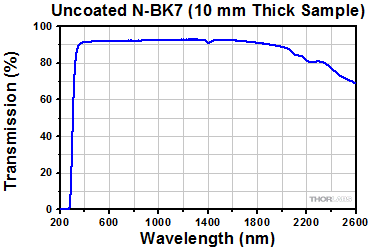

 Plano-Convex, N-BK7, Uncoated
Plano-Convex, N-BK7, Uncoated